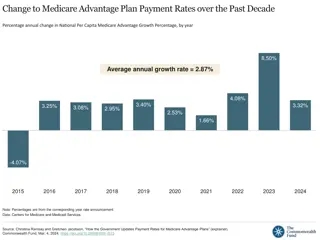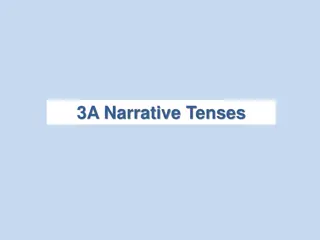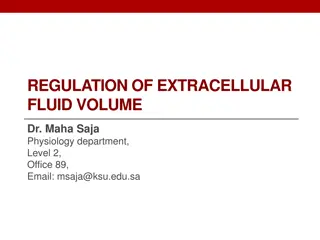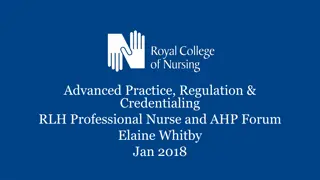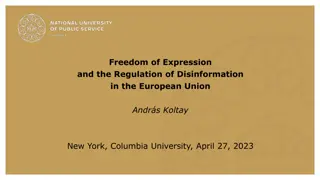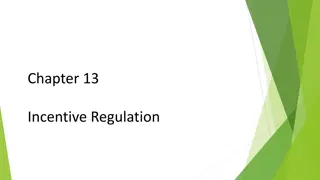Reflections on Financial Regulation Over the Past Decade
Assessing the decade of financial regulation reveals improvements in bank capitalization and systemic risk management. However, challenges remain with sovereign debt levels, low interest rates, and political support for further reforms. The discussion also looks ahead to potential future crises originating from non-bank entities and emerging markets. Adaptation to digital disruption and ensuring financial stability in an evolving regulatory landscape are highlighted as crucial tasks. The need for holistic prudential regulation with effective stress tests and a systemic perspective is emphasized.
Download Presentation

Please find below an Image/Link to download the presentation.
The content on the website is provided AS IS for your information and personal use only. It may not be sold, licensed, or shared on other websites without obtaining consent from the author.If you encounter any issues during the download, it is possible that the publisher has removed the file from their server.
You are allowed to download the files provided on this website for personal or commercial use, subject to the condition that they are used lawfully. All files are the property of their respective owners.
The content on the website is provided AS IS for your information and personal use only. It may not be sold, licensed, or shared on other websites without obtaining consent from the author.
E N D
Presentation Transcript
Sound at last? Assessing a decade of financial regulation Xavier Vives Director Banking Initiative IESE Business School Brussels, June 20, 2019
Banking industry in the aftermath of the crisis Since the global financial crisis regulation and supervision improved: Banks are better capitalised. Authorities now pay more attention on systemic risk. On the other hand, advanced economies are also experiencing high sovereign debt to GDP ratios and very low persistent levels of interest rates. Authorities lack necessary political support to take forward the reforms and appropriate regulation. Sufficient powers to deal with major crises in doubt End bailouts is the political reaction to the past crisis. Completion of the Banking Union in the Eurozone is still under discussion and unrealistic commitments to end bailouts undermine it. Credibility of regulators is at stake: Politics as the very source of instability. 3
Looking forward The next global crisis may have different origins, possibly: In entities that perform the functions of banks but are outside of the regulatory perimeter. In an emerging market where regulation could well be different from the reformed patterns of the West. Challenges Incumbent banks must adapt to digital disruption and to the increasingly competitive environment it created. Regulators must maintain a level playing field and protect financial stability while allowing the benefits of innovation to permeate the system. 4
Sound at last? Assessing a decade of financial regulation Regulatory Reform: Basel III and Beyond Resolving TBTF An Enlarged Role for Central Banks 5
Sound at last? Assessing a decade of financial regulation REGULATORY REFORM: BASEL III AND BEYOND Observation: Narrow banking is not a magic bullet The inherent fragility of the banking core function would resurface elsewhere in the financial system. 6
Prudential Regulation (I) Prudential regulation should take a holistic approach setting requirements for capital, liquidity and disclosure together, taking account of their potential interactions, including the competitive conditions of the industry. Stress tests are very useful if well designed: Need to be severe, flexible and not overly transparent. Need to incorporate a systemic perspective. Main lesson from the euro area: effective stress tests can only be implemented when there is a backstop for the banking system. 7
Prudential Regulation (II) 1. Capital: Requirements & levels are up, but enough? 2. Liquidity: One requirement may be enough LCR 3. Non-banks: Need of a framework to monitor, assess, designate, regulate & supervise 8
Capital Requirements: Risk-weighted and Leverage Ratio RWA: 2009: 5.7% 2018: 13.9% Leverage ratio: 2009: 2.8% 2018: 5.8% Basel Committee Quantitative Impact Study (QIS) estimated ratio of common-equity tier 1 capital to risk-weighted assets or tier 1 capital to total assets using fully phased-in Basel III definitions. Data from 2011 to 2018 are from a consistent sample of 66 large internationally active banks with tier 1 capital in excess of 3 billion. 9
Capital Requirements Comparing Basel III & Basel II Risk-weighted Capital Requirements 8% to 10% Basel III range 4% Basel II Baseline -2% Adjustment for hybrid capital Adjustment for goodwill, intangibles, deferred tax assets, etc. -1% - % Adjustment for changes in risk weights < % Effective Basel II converted to a Basel III basis Basel III >10 times Basel II! 10
Liquidity Requirements: Some Balance Sheet Arithmetic Assets Liabilities LCR: Liquid Runnable Liquid Runnable Illiquid Stable NSFR: Illiquid Stable 11
Non-bank Intermediation Global financial system assets by sector 2007 to 2017: Globally: Banks (48% to 44%) Nonbanks (31% to 36%) Financial Stability Board (2019), monitoring dataset. 12
Non-bank Intermediation For entities outside the perimeter of regulation, authorities require a framework to: Monitor Assess Designate Regulate Supervise 13



